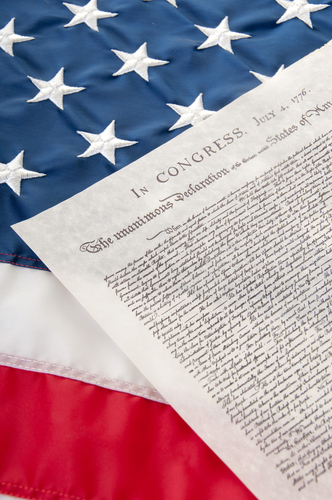
The United States Constitution has been amended 27 times since it was first ratified in 1788. The Constitution ensures that every American citizen has basic rights that the government cannot infringe upon. Each amendment was added to the Constitution to address specific issues and controversies that arose over time. Understanding these amendments is necessary to understand the protections and liberties granted by the Constitution. Here is a brief overview of the amendments to the United States Constitution:
1st Amendment – The First Amendment includes freedom of speech, freedom of religion, freedom of the press, freedom to assemble, and the right to petition the government for a redress of grievances. It is a cornerstone of American democracy and allows individuals to express their views without fear of government censorship.
2nd Amendment – The Second Amendment provides for the right to bear arms. This amendment has been the subject of controversy and debate due to differing interpretations of its language and intent.
3rd Amendment – The Third Amendment prohibits the government from forcing citizens to allow the quartering of soldiers in their homes without their consent.
4th Amendment – The Fourth Amendment provides protection against unreasonable searches and seizures. It requires that the government obtain a warrant before searching a person’s property or person.
5th Amendment – The Fifth Amendment includes the protection against self-incrimination and double jeopardy, the right to due process of law, and the requirement that the government justly compensate citizens for any property taken through eminent domain.
6th Amendment – The Sixth Amendment guarantees the right to a fair and speedy trial, the right to an impartial jury, and the right to confront witnesses.
7th Amendment – The Seventh Amendment provides for the right to a trial by jury in civil cases.
8th Amendment – The Eighth Amendment prohibits cruel and unusual punishment, as well as excessive bail and fines.
9th Amendment – The Ninth Amendment ensures that individuals have other fundamental rights that are not listed in the Constitution.
10th Amendment – The Tenth Amendment reserves powers not granted to the federal government to the states or the people.
11th Amendment – The Eleventh Amendment limits the ability of individuals to sue states in federal court.
12th Amendment – The Twelfth Amendment outlines the procedures for electing the President and Vice President.
13th Amendment – The Thirteenth Amendment abolished slavery and involuntary servitude.
14th Amendment – The Fourteenth Amendment required states to grant citizenship to all persons born or naturalized in the United States, and also ensured that every person would have equal protection under the law.
15th Amendment – The Fifteenth Amendment prohibited the denial of the right to vote based on race, color, or previous condition of servitude.
16th Amendment – The Sixteenth Amendment allowed Congress to pass an income tax.
17th Amendment – The Seventeenth Amendment established the direct election of senators by the people.
18th Amendment – The Eighteenth Amendment prohibited the manufacture, transportation, and sale of alcohol.
19th Amendment – The Nineteenth Amendment granted women the right to vote.
20th Amendment – The Twentieth Amendment established the terms of the President and Congress and the date of the Presidential inauguration.
21st Amendment – The Twenty-first Amendment repealed the prohibition on alcohol.
22nd Amendment – The Twenty-second Amendment limited the President’s term of office to two terms, or a maximum of ten years.
23rd Amendment – The Twenty-third Amendment provided for citizens of Washington, D.C. to vote in Presidential elections.
24th Amendment – The Twenty-fourth Amendment prohibited poll taxes in federal elections.
25th Amendment – The Twenty-fifth Amendment established procedures for Presidential succession and created the office of the Vice President, as well as the mechanism for the Vice President to assume the Presidency in the event of Presidential disability.
26th Amendment – The Twenty-sixth Amendment lowered the voting age from 21 to 18.
27th Amendment – The Twenty-seventh Amendment regulates congressional pay, restraining congressional salary increases.
Conclusion
The amendments to the United States Constitution are significant parts of American history, and knowing them is an essential part of being an engaged citizen. These amendments reflect the changing needs and values of society over time and helped shape the United States into the country it is today. Understanding the amendments also ensures that citizens can protect their fundamental rights and hold the government accountable when necessary.
The Constitution of the United States is a governing document that upholds and outlines the rights of the individuals of the United States under law. It is a document that is very hard to change. This was a conscious decision made by the Founding Fathers. Those who created and helped to fashion the Constitution understood the importance of this one document. They created stipulations that have to be adhered to in order to make amendments to the Constitution.
The process of having the Constitution amended starts off with the proposal of an Amendment. A proposal of an Amendment can happen in one of two ways. First, it can be a proposal that is done within the body of Congress. It must be brought to the floor, discussed, and voted on.
The vote requires a two-thirds majority in both the House of Representatives and the Senate. This must be done on more than one occasion.
The second way in which a proposal can occur is through a Constitutional Convention. This type of convention can be called for by the members of Congress using a two-thirds majority. If a Constitutional Convention occurs, this is where changes can be made and Amendments can be proposed.
Before it can be made an Amendment to the Constitution, the proposed amendment must be ratified. How this happens is the Amendment is then brought out to all of the states and is requested for a vote by State Legislature or designated State conventions. In order for the Constitution to be amended, three-fourths of the states must vote in favor of ratifying the proposed Amendment. If voted in, the Amendment to the Constitution can be official.


























